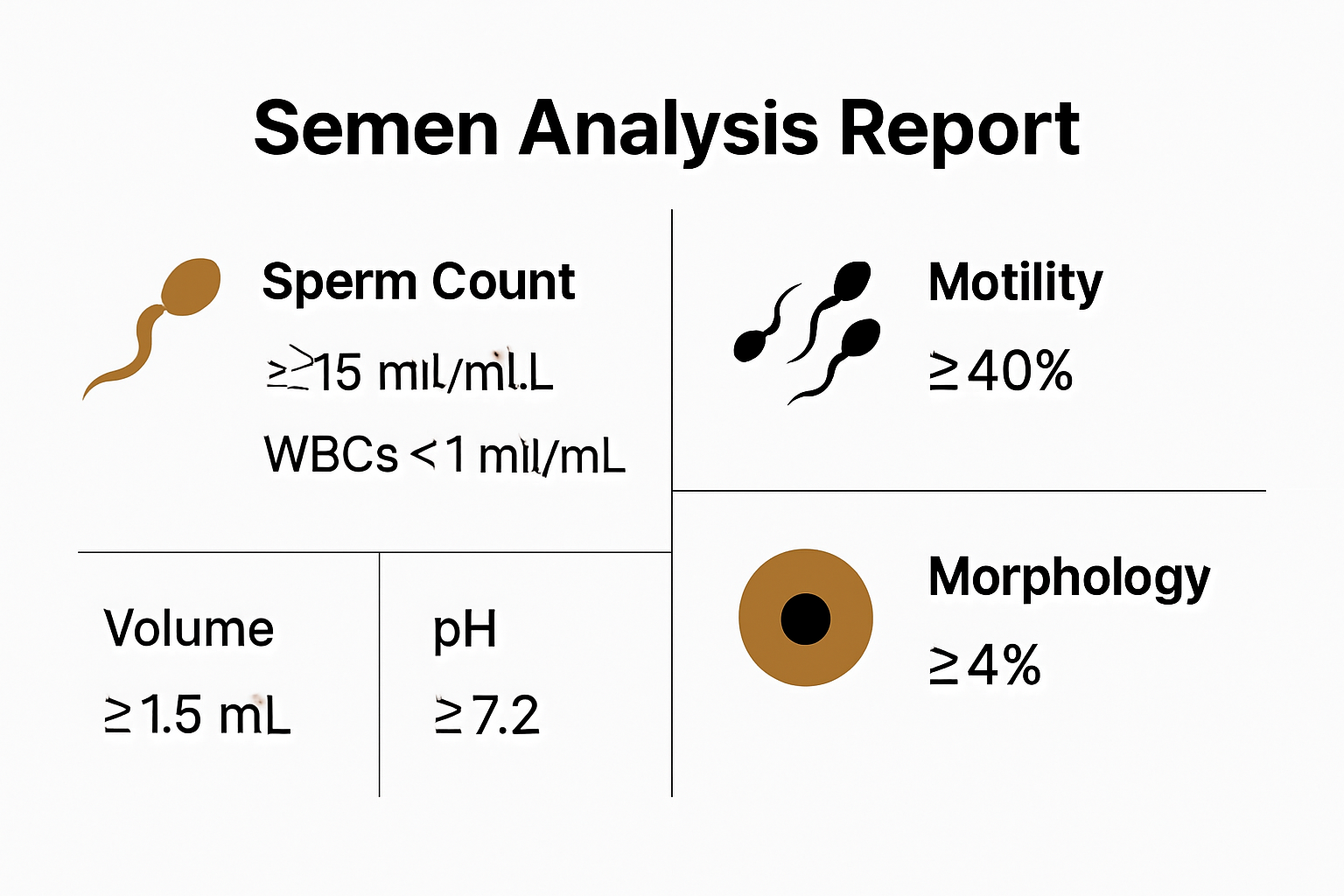Semen analysis reports hold more insights than most people think. Many focus on the sperm count number or hope for a single word: ‘zero.’ Here’s something that stands out. A successful vasectomy is usually shown by complete azoospermia or less than 100,000 nonmotile sperm per milliliter in post-vasectomy analysis. That might sound straightforward, but the truth is dozens of men each year get surprised by unexpected motile sperm or abnormal results long after their procedure. Understanding how to read every section of your semen report reveals much more about your fertility and overall health than you’d expect.
Table of Contents
- Key Parts Of Your Semen Analysis Report
- Understanding Results After Vasectomy
- What Semen Results Mean For Fertility
- When To Speak With Your Doctor About Results
Quick Summary
| Takeaway | Explanation |
|---|---|
| Understanding Normal Sperm Parameters | Sperm count, motility, and morphology are critical indicators of reproductive health, with normal sperm concentration ranging from 15 million to 39 million per milliliter and motility benchmarks at 32% or higher for effective conception. |
| Vasectomy Success Criteria | A successful vasectomy is typically indicated by complete azoospermia (zero sperm) or less than 100,000 nonmotile sperm per milliliter in post-vasectomy analysis, requiring follow-up tests to confirm sterility. |
| Red Flags to Consult a Doctor | Presence of motile sperm or persistent nonmotile sperm counts above specific thresholds after a vasectomy should prompt immediate consultation with a healthcare professional to rule out potential procedural failure or health issues. |
| Comprehensive Health Considerations | Beyond semen analysis numbers, factors like medical history, lifestyle, and fertility goals are essential when discussing results with a healthcare provider, emphasizing a holistic approach to reproductive health. |
Key Parts of Your Semen Analysis Report
Understanding your semen analysis report requires knowing the key components that medical professionals evaluate. Whether you have recently undergone a vasectomy or are exploring fertility options, decoding these results helps you make informed decisions about your reproductive health.

Understanding Sperm Count and Concentration
Sperm count represents the total number of sperm cells in your ejaculate, while concentration measures sperm density per milliliter. For men who have had a vasectomy, the primary goal is confirming azoospermia (zero sperm). Learn more about sperm analysis terms to better comprehend your results.
According to clinical guidelines from LabCorp, successful vasectomy results show fewer than 0.1 million nonmotile sperm per milliliter. Specifically, azoospermia or extremely low sperm counts indicate the procedure’s effectiveness. Persistent higher counts might require additional evaluation or potentially repeating the vasectomy procedure.
Sperm Motility and Morphology Analysis
Sperm motility measures the percentage of moving sperm cells and their movement quality. Progressive motility indicates sperm capable of swimming forward effectively. Fertility Centers of California notes that normal total motility is around 40%, with progressive motility at 32% or higher being crucial for natural conception.
Morphology examines sperm shape and structural characteristics. Normal sperm have oval heads and long tails, enabling efficient movement. Abnormal morphology can impact fertility potential. For vasectomy confirmation, the focus remains on identifying any remaining sperm presence.
Additional Semen Parameters
Beyond sperm metrics, your report includes other critical measurements. Semen volume typically ranges between 2-5 milliliters. PH levels and white blood cell counts provide insights into potential infections or inflammatory conditions that might affect reproductive health.
Reading a semen analysis report requires understanding these nuanced metrics. While the numbers might seem complex, they offer a comprehensive snapshot of your reproductive status. Always consult with a healthcare professional to interpret your specific results and discuss any potential follow-up actions.
Understanding Results After Vasectomy
After a vasectomy, interpreting your semen analysis results is crucial to confirming the procedure’s success. The post-vasectomy semen analysis (PVSA) provides critical insights into your reproductive status and helps determine whether additional precautions are necessary.
Defining Vasectomy Success Criteria
Vasectomy success is scientifically defined by specific sperm count parameters. Learn more about confirming vasectomy success to fully understand the nuanced evaluation process. According to the American Urological Association, a successful vasectomy demonstrates either complete azoospermia (zero sperm) or fewer than 100,000 nonmotile sperm per milliliter.
A comprehensive study involving 4,827 men revealed fascinating statistics about post-vasectomy outcomes. Approximately 58.2% of participants achieved complete azoospermia, while 28.3% showed rare nonmotile sperm counts. Remarkably, only 4.8% had motile sperm, underscoring the high effectiveness of modern vasectomy procedures.
Interpreting Potential Result Scenarios

Semen analysis results after vasectomy can fall into three primary categories. First, complete azoospermia indicates an ideal outcome where no sperm are detected. Second, rare nonmotile sperm (less than 100,000 per milliliter) generally suggests successful sterilization. Third, persistent high sperm counts or the presence of motile sperm might necessitate further medical evaluation.
Clinical guidelines from LabCorp emphasize that persistent sperm counts above 100,000 nonmotile sperm per milliliter beyond six months post-procedure could indicate potential vasectomy failure. In such scenarios, healthcare professionals recommend serial analyses and potential repeat procedures to ensure reproductive sterility.
Follow-Up and Continued Monitoring
Post-vasectomy monitoring extends beyond the initial semen analysis. Experts recommend multiple analyses to confirm consistent results. The typical protocol involves producing semen samples at specific intervals post-procedure—often at three and six months—to track sperm reduction and confirm sustained sterility.
Patients should maintain open communication with their healthcare provider, discussing any unexpected findings or concerns. While modern vasectomy techniques boast high success rates, individual variations exist. Understanding your specific results empowers you to make informed decisions about contraception and reproductive health.
Remember, a comprehensive interpretation of your semen analysis requires professional medical consultation. Your specific results should be thoroughly discussed with a urologist who can provide personalized insights based on your unique medical history and procedure details.
What Semen Results Mean for Fertility
Semen analysis results provide a comprehensive window into male reproductive health, offering critical insights beyond simple fertility assessment. Understanding these results helps individuals and couples make informed decisions about family planning and potential reproductive challenges.
Decoding Fertility Potential
Sperm parameters reveal far more than simple presence or absence. Learn more about advanced sperm function tests to comprehend the intricate details of reproductive health. Fertility specialists evaluate multiple key metrics that collectively determine reproductive potential.
Sperm concentration represents the foundational metric. According to the World Health Organization, normal sperm concentration ranges from 15 million to 39 million sperm per milliliter. Lower concentrations can significantly impact conception chances. Each parameter tells a specific story about reproductive capability.
Critical Sperm Health Indicators
Beyond quantity, sperm quality plays a crucial role in fertility. Motility measures sperm movement effectiveness—a critical factor for successful fertilization. Progressive motility indicates sperm capable of swimming forward, which is essential for reaching and penetrating an egg. The American Society for Reproductive Medicine suggests that normal progressive motility should be around 32% of total sperm.
Morphology examines sperm shape and structural integrity. Normal sperm have oval heads and long, straight tails. Abnormal morphology can impede fertilization potential. Research indicates that sperm with irregular shapes may struggle to penetrate an egg, reducing overall fertility potential.
Beyond Basic Measurements
Semen analysis provides nuanced insights into reproductive health. Additional factors like semen volume, pH levels, and white blood cell counts offer comprehensive reproductive health snapshots. Volume between 1.5 to 5 milliliters indicates healthy seminal fluid production. Abnormal volumes might signal underlying reproductive system issues.
While numbers provide valuable information, context is paramount. Individual variations exist, and a single analysis cannot definitively determine fertility. Multiple tests over time offer more reliable insights. Consulting a reproductive healthcare professional helps interpret results accurately and develop personalized reproductive strategies.
Remember that fertility is complex. Semen analysis represents one piece of a larger reproductive health puzzle. Lifestyle factors, medical history, and overall health significantly influence fertility potential. Approach results with balanced perspective, understanding that modern medical interventions offer numerous paths to successful family planning.
When to Speak With Your Doctor About Results
Navigating semen analysis results can be complex, and knowing when to consult a healthcare professional is crucial for your reproductive health. Understanding the right moments to seek medical guidance ensures comprehensive care and early intervention if needed.
Red Flags in Semen Analysis Results
Certain findings in your semen analysis warrant immediate medical consultation. Explore detailed guidance on interpreting test results to understand potential concerns. The American Urological Association recommends speaking with your doctor if post-vasectomy semen analysis reveals more than 100,000 nonmotile sperm per milliliter beyond six months after the procedure.
Specifically, motile sperm presence after a vasectomy is a significant red flag. According to clinical research, the detection of moving sperm suggests potential vasectomy failure or recanalization—a process where the vas deferens reconnects, allowing sperm passage. This scenario requires immediate professional evaluation and potentially a repeat vasectomy procedure.
Interpreting Persistent Abnormal Findings
Consistent abnormal results across multiple semen analyses demand professional attention. LabCorp clinical guidelines emphasize the importance of serial analyses and clinical judgment. Repeated findings of low sperm concentration, poor motility, or unusual morphology could indicate underlying reproductive health issues.
Factors that should prompt a doctor consultation include:
- Sperm concentration consistently below 15 million per milliliter
- Progressive motility less than 32%
- Abnormal sperm morphology affecting more than 96% of sperm
- Significant variations in semen volume
- Presence of white blood cells suggesting potential infection
Beyond the Numbers: Comprehensive Reproductive Health
Doctor consultations extend beyond numerical results. Your medical history, lifestyle factors, and overall health play crucial roles in interpreting semen analysis. Discuss your results comprehensively, including:
- Recent health changes
- Medication use
- Lifestyle modifications
- Family planning goals
- Potential fertility concerns
A healthcare professional can provide context-rich interpretation, helping you understand your reproductive health holistically. They might recommend additional tests, lifestyle adjustments, or specialized interventions based on your unique situation.
Remember, semen analysis is a diagnostic tool, not a definitive judgment. Approach your results with an open mind and proactive attitude. Consulting a urologist or reproductive health specialist transforms raw data into actionable insights for your reproductive journey.
Frequently Asked Questions
What does azoospermia mean in a semen analysis after a vasectomy?
Azoospermia refers to the complete absence of sperm in the semen. In the context of a vasectomy, it indicates a successful procedure, confirming that no sperm are present and the individual is effectively sterile.
What are the success criteria for a vasectomy based on semen analysis results?
A successful vasectomy is indicated by complete azoospermia or fewer than 100,000 nonmotile sperm per milliliter in post-vasectomy semen analysis. These criteria help ensure that the procedure was effective in preventing sperm release.
What should I do if I have motile sperm in my semen analysis after a vasectomy?
Presence of motile sperm after a vasectomy is considered a significant red flag. It may indicate potential failure of the procedure or recanalization of the vas deferens. Consult with a healthcare professional immediately for further evaluation and possible repeat vasectomy.
How often should I have a semen analysis after my vasectomy?
It is recommended to have follow-up semen analyses at specific intervals, typically three and six months after the procedure. This monitoring helps to confirm consistent results and ensure sustained sterility.





